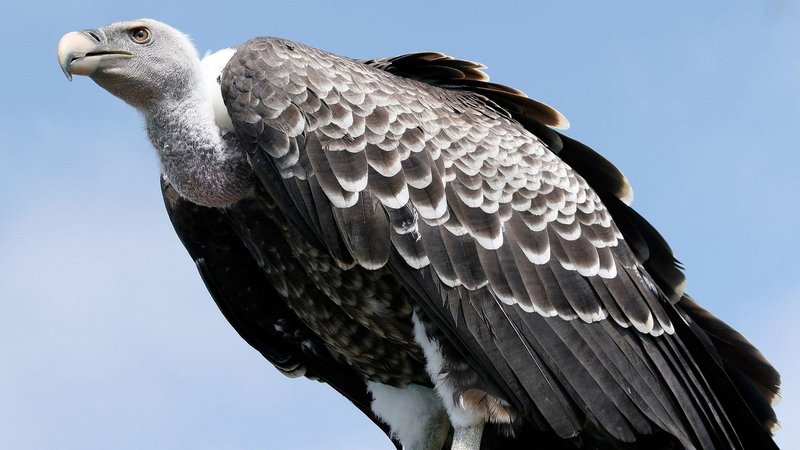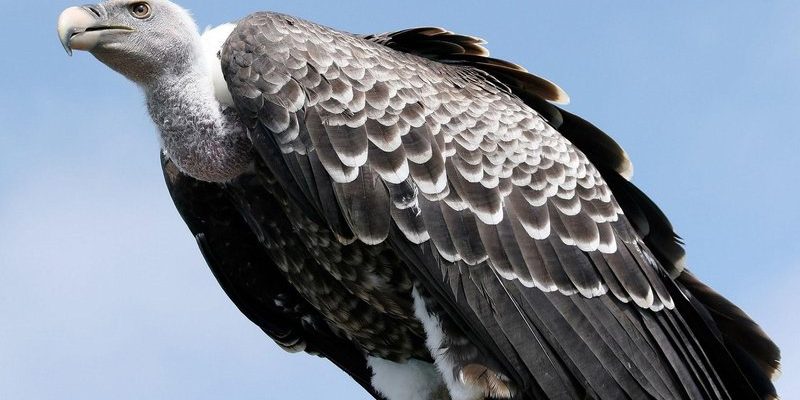
The Bearded Vulture, also known as the Lammergeier, is a bird that captures the imagination with its striking appearance and unique behavior. Found in mountainous regions, it stands out not just for its size but also for its distinctive golden neck feathers that give it a regal look. If you’ve ever marveled at a vulture soaring high above the peaks, the Bearded Vulture is a perfect example of nature’s artistry. It’s not just another bird; it’s a creature that embodies the wild spirit of the high mountains.
One of the most intriguing aspects of the Bearded Vulture is its diet. Unlike many other vultures that feed on carrion, this bird has a penchant for bones. That’s right! It has developed a unique method for consuming even the toughest of bones, which sets it apart from its scavenging relatives. Imagine a bird that can literally crack bones open to get to the nutritious marrow inside. This remarkable trait not only highlights the adaptability of the Bearded Vulture but also its critical role in the ecosystem.
Physical Characteristics
The Bearded Vulture is one of the largest raptors in Europe and across the mountain ranges of Asia and Africa. Males typically weigh between 5.5 to 7.5 kg, while females can weigh up to 9 kg. Their wingspan is an impressive 2.7 to 3 meters, making them one of the most formidable fliers among birds. The coloring is equally captivating; their plumage is primarily dark with striking reddish-brown and pale golden neck feathers that seem to glow in the sunlight. These features not only make them a beauty to behold but are also essential for their survival.
What’s particularly fascinating is how their feathers play a role in their identity. The Bearded Vulture’s feathers are not just for show; they serve as a protective barrier against the harsh mountain winds and elements. The large, powerful beak is uniquely designed to tear through flesh and crush bone, reflecting their specialized feeding habits. When you see a Bearded Vulture in flight, it feels like a living piece of art gliding through the air, effortlessly navigating the rugged landscapes of its habitat.
Size Comparison
| Characteristic | Bearded Vulture | Common Vulture |
| Weight | 5.5 – 9 kg | 4.5 – 8 kg |
| Wingspan | 2.7 – 3 m | 2.5 – 2.8 m |
| Length | 95 – 110 cm | 80 – 100 cm |
Habitat and Distribution
Bearded Vultures thrive in high-altitude environments, often found in rocky mountainous terrains where they can soar and scan vast areas for food. Their preference for rugged, remote locations means they are typically found in the Alps, the Himalayas, and the mountains of Africa. These regions provide the necessary cliffs for nesting and the vast open spaces for flying and hunting.
Interestingly, the Bearded Vulture is more than just a creature of the mountains; it has adapted to thrive in various habitats. In Europe, you might spot them in the Pyrenees or the Alps, while in Asia, they can be found in the Tibetan Plateau. This adaptability showcases their resilience, managing to find food and shelter in diverse terrains. Despite their range, they are often solitary or found in pairs, adding an air of mystery to their lifestyles.
Diet and Feeding Habits
What truly sets the Bearded Vulture apart from its avian cousins is its extraordinary diet. While many scavengers feast on leftover carcasses, the Bearded Vulture primarily targets the bones of dead animals. The bird’s powerful beak allows it to crush bones and access the nutrient-rich marrow inside. This practice not only ensures a diet rich in calcium and protein but also plays a pivotal role in nutrient cycling within their ecosystem.
To consume these bones effectively, Bearded Vultures have developed a unique feeding technique. They often pick up bones, fly high above the ground, and then drop them onto rocks below to shatter them. This method is fascinating to observe and reflects their intelligence and problem-solving skills. Imagine witnessing an aerial display where this bird, soaring effortlessly through the sky, drops a bone onto a rock below — it’s a remarkable sight! This feeding behavior also benefits other scavengers, as the remnants of the shattered bones are available for them to eat.
Breeding and Nesting
The breeding season for Bearded Vultures typically occurs between December and March. During this time, these birds are known for their elaborate courtship displays, which include aerial acrobatics and synchronized flights. Once paired, they create a lifelong bond, often returning to the same nesting site year after year. This loyalty is heartwarming and speaks to their committed nature.
Nests are typically built on ledges of steep cliffs, providing safety from predators. They construct their nests using sticks and bones, creating a sturdy home for their young. The female usually lays one to two eggs, which both parents incubate for about 50 days. When the chicks hatch, they rely entirely on their parents for food, which can be a challenge given their unique diet. As the chicks grow, both parents work hard to teach them the necessary skills for survival in their harsh mountain environment.
Conservation Status
Once widespread, the Bearded Vulture has faced significant population declines due to habitat loss, poisoning, and hunting. They are currently classified as Near Threatened by the IUCN Red List. Efforts to conserve this majestic bird are ongoing, with several programs aimed at protecting their habitats and raising awareness about their importance in the ecosystem. Conservation groups are working diligently to create protected areas and corridors that allow these birds to thrive.
You might be wondering how you can help. One of the best ways is by supporting organizations focused on wildlife conservation and participating in local efforts to protect natural habitats. Every little bit counts in ensuring that future generations can also witness the beauty of the Bearded Vulture soaring through the skies.
Behavior and Social Structure
The Bearded Vulture is a solitary bird but can sometimes be seen in small groups, particularly at feeding sites. They are known for their playful nature, often engaging in aerial antics such as chasing each other and performing barrel rolls. This behavior not only serves as a bonding activity but may also play a role in honing their flying skills. Observing these majestic birds in flight is nothing short of mesmerizing, as they glide gracefully against the backdrop of a clear blue sky.
When it comes to communication, Bearded Vultures are relatively quiet compared to more vocal bird species. They mainly communicate through body language and subtle movements. However, they do produce a range of low croaks and hisses, especially during courtship displays or when protecting their territory. If you ever get a chance to witness a Bearded Vulture up close, pay attention to how it interacts with its environment; you might see something spectacular!
Threats to the Bearded Vulture
The challenges faced by the Bearded Vulture are considerable, primarily the loss of habitat due to human encroachment and climate change. As more development occurs in their mountainous habitats, suitable nesting sites and food sources become increasingly scarce. Additionally, poisoning, whether intentional or accidental, poses a significant threat to their population. Lead poisoning from ingesting spent ammunition is particularly concerning.
Another threat comes from the decrease in the population of wild ungulates, which affects the availability of food. As their primary food sources dwindle, Bearded Vultures may struggle to find enough nourishment, leading to declines in their population. Conservation programs are crucial in mitigating these threats, helping to restore their habitats and promote awareness about the importance of these magnificent birds in our ecosystems.
The Bearded Vulture is a remarkable bird that embodies the spirit of the high mountains. With its striking appearance, unique feeding habits, and intriguing social structure, it’s no wonder this bird has fascinated people for centuries. As you learn more about these incredible creatures, remember that they play an essential role in their ecosystems, and their survival is intertwined with the health of their environments.
By understanding and advocating for the Bearded Vulture, you become a part of the effort to ensure this bird and its habitat thrive for generations to come. Whether it’s through supporting conservation efforts or simply appreciating the beauty of nature, every action counts. So next time you find yourself in mountainous areas, keep an eye on the skies — you might just catch a glimpse of the majestic Bearded Vulture.
FAQ
What is the Bearded Vulture’s primary food source?
The Bearded Vulture primarily feeds on bones, which it crushes using its powerful beak. This dietary preference sets it apart from other vultures that typically feed on carrion. The Bearded Vulture’s unique feeding habits allow it to extract nutritious marrow from bones, making it an important player in nutrient cycling within its ecosystem.
Where can Bearded Vultures be found?
Bearded Vultures are found in mountainous regions across Europe, Asia, and Africa. They thrive in high-altitude environments, often nesting on cliffs and rocky ledges. You might spot them in locations such as the Alps, the Himalayas, and the Tibetan Plateau, where they can soar gracefully against the stunning mountain backdrops.
How do Bearded Vultures breed?
Bearded Vultures typically engage in complex courtship displays during the breeding season, which occurs between December and March. They form lifelong pairs and return to the same nesting sites each year. The female lays one to two eggs, which both parents incubate for about 50 days before the chicks hatch.
Are Bearded Vultures social birds?
While Bearded Vultures are primarily solitary, they can be seen in small groups, especially at feeding sites. They engage in playful aerial displays and may interact during courtship. Their communication is subtle, mainly relying on body language and low vocalizations.
What threats do Bearded Vultures face?
Bearded Vultures face several threats, including habitat loss, poisoning, and a decline in wild ungulate populations. The loss of their natural habitat due to human encroachment and climate change significantly impacts their survival. Conservation efforts are crucial for their protection.
How can I help Bearded Vultures?
You can help Bearded Vultures by supporting wildlife conservation organizations and participating in local efforts to protect their habitats. Raising awareness about the importance of these birds can also contribute to their conservation and ensure that they thrive in the wild.
Do Bearded Vultures migrate?
Bearded Vultures are not known for long migratory patterns like some other birds; instead, they tend to remain in their mountainous habitats throughout the year. However, they may move to lower elevations during extreme weather conditions to find food and shelter.
How long do Bearded Vultures live?
In the wild, Bearded Vultures can live for around 20 to 30 years, although some individuals may live even longer under optimal conditions. Their longevity is partly due to their position as apex predators, with few natural threats when mature.
What role do Bearded Vultures play in their ecosystem?
Bearded Vultures play an essential role in their ecosystem by helping with the decomposition of animal remains and contributing to nutrient cycling. By breaking down bones and recycling nutrients back into the environment, they support the health of the ecosystem.
Can Bearded Vultures be found in zoos?
Yes, Bearded Vultures can be found in some zoos and wildlife reserves, where they are part of conservation programs aimed at educating the public about their importance and helping to maintain genetic diversity while protecting this vulnerable species.

